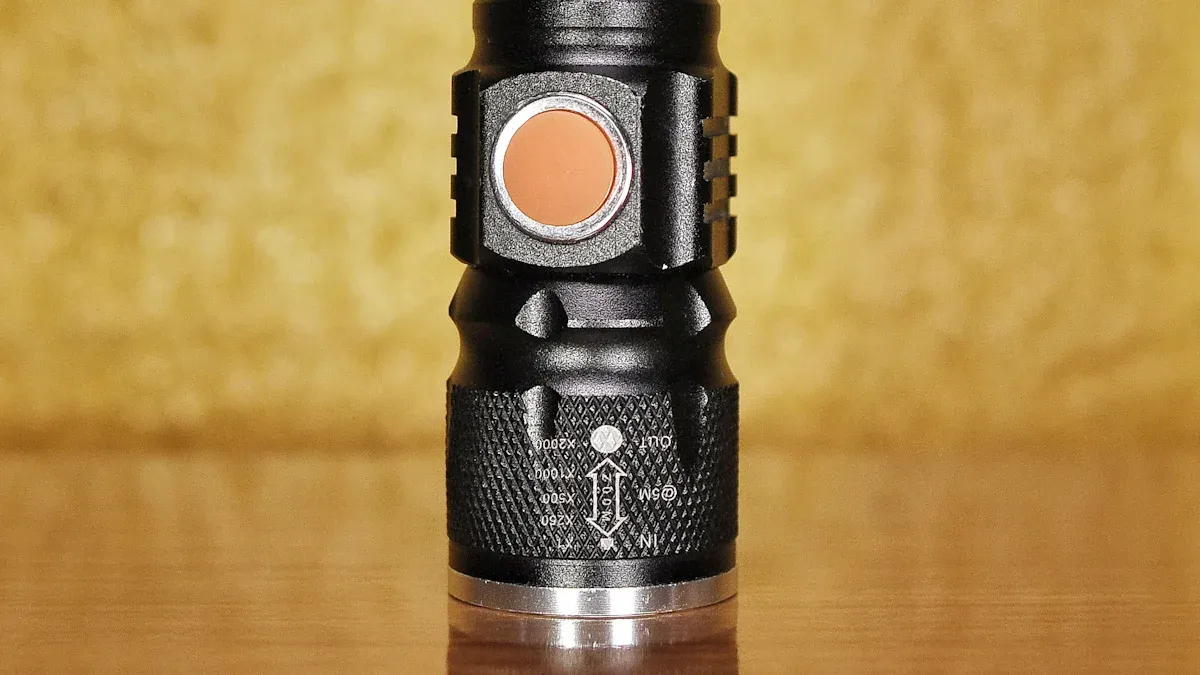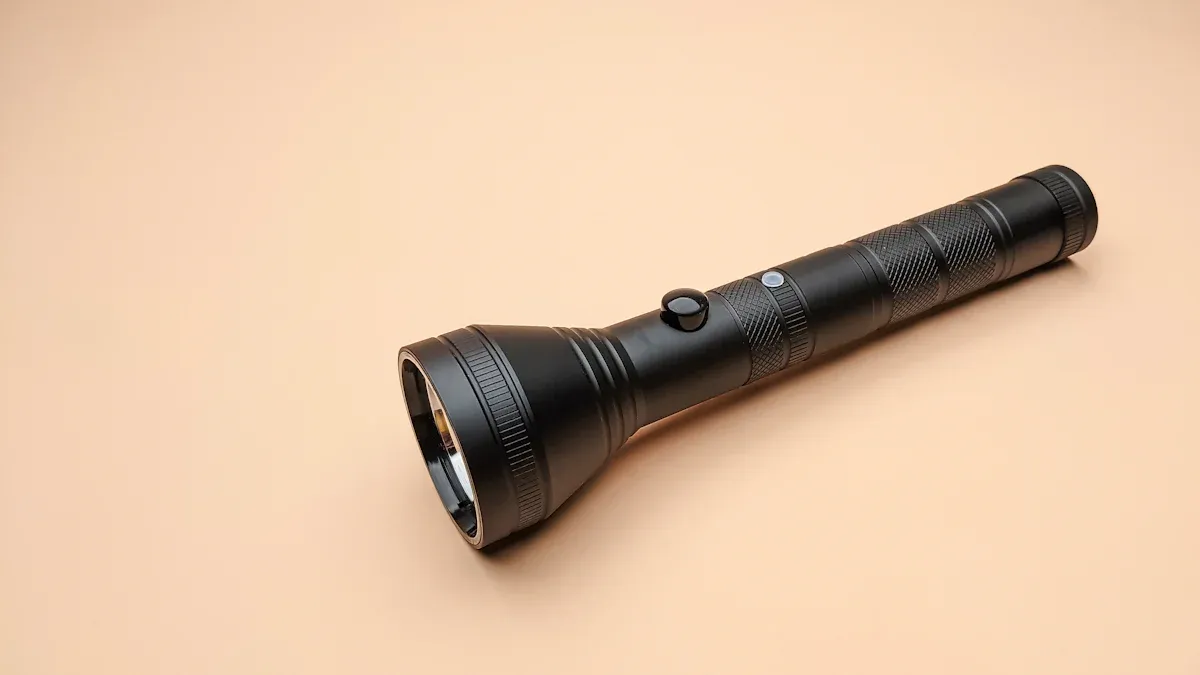Best Flashlights for Hikers: Compact, Durable, and Powerful Lights

When you’re out hiking, a reliable flashlight can make all the difference. It ensures you stay safe on dim trails and helps you set up camp after sunset. Models like the PD36R or the helius flashlight offer powerful light, long runtimes, and weather resistance. These features are essential for any outdoor adventure.
Key Takeaways
Pick a flashlight with 1,000 lumens or more for clear trails.
Find one made of strong materials like aluminum or titanium.
Check the weight and size; smaller ones are easier to carry.
Best Flashlights for Hikers: Top Picks

Best Overall Flashlight for Hiking
When it comes to the best overall flashlight for hiking, you want a model that balances brightness, durability, and ease of use. A flashlight with at least 1,000 lumens ensures you’ll have enough light for any trail. Look for features like weather resistance and a compact design to make it easy to carry. Here’s a quick breakdown of what makes the best overall flashlight stand out:
Criteria | Description |
|---|---|
Lumens | Provides up to 1,000 lumens for excellent visibility. |
Runtime | Offers long-lasting light for extended hikes. |
Battery Type | Works with rechargeable or disposable batteries for flexibility. |
Lightweight & Compact | Easy to carry without adding bulk to your gear. |
Durability | Built to withstand impacts, dirt, and moisture. |
Weather Resistance | Protects against rain, snow, and humidity. |
Ease of Use | Simple controls for quick adjustments, even in low-light conditions. |
This combination of features ensures you’re prepared for any hiking adventure.
Best Budget-Friendly Flashlight
If you’re looking for the best budget flashlight, you don’t have to sacrifice quality. Many affordable options offer impressive brightness and durability. Some models even include strobe modes for emergencies or magnetic tailcaps for hands-free use. Here’s what to look for in a budget-friendly flashlight:
Feature | Description |
|---|---|
Brightness | Up to 2,000 lumens for clear visibility. |
Battery Life | Lasts up to 200 hours in low mode. |
Durability | Made from aircraft-grade aluminum and rated IP68 waterproof. |
Ease of Use | Simple controls like a single switch or tail button. |
Additional Features | Includes strobe modes and magnetic tailcaps for added convenience. |
These flashlights provide the best value for hikers who want reliable performance without breaking the bank.
Best Lightweight Flashlight for Backpacking
For backpacking, every ounce counts. The best ultralight flashlights weigh less than an ounce but still deliver powerful light. Here’s a comparison of some top options:
Flashlight Weight | Max Lumens | Runtime |
|---|---|---|
0.88 oz | 85 | 45 minutes |
0.66 oz | 500 | 15 minutes |
These backpacking flashlights are perfect for hikers who prioritize weight savings without compromising on performance.
Best Rechargeable Flashlight
A rechargeable flashlight is a smart choice for hikers who want convenience and cost savings. Rechargeable batteries can be used multiple times, making them eco-friendly and budget-friendly. They’re also easy to recharge during multi-day hikes if you carry a portable power bank.
Best Flashlight for Long-Distance Illumination
If you need a flashlight for long-distance illumination, beam distance is key. Some models can reach over 2,000 meters, making them ideal for spotting distant landmarks or navigating open terrain. Here’s a quick look at some of the best options:
Flashlight Model | Maximum Beam Distance | Maximum Output (lumens) |
|---|---|---|
Manker MK38 | 800 meters | 41,500 |
OLIGHT Javelot Pro 2 | 1,050 meters | 2,500 |
NITECORE P35i | 1,650 meters | 3,000 |
FENIX LR50R | 950 meters | 12,000 |
Astrolux MF04 | 2,000 meters | N/A |
Amutorch DM90 | 2,474 meters | N/A |
These powerful LED flashlights ensure you’ll never lose sight of your path, no matter how far you need to see.
Helius Flashlight: A Reliable Option for Hikers
The helius flashlight is a top choice for hikers who want a dependable and versatile light. It offers up to 2,000 lumens of brightness, making it perfect for any trail. Its durable, aircraft-grade aluminum body is IP68 waterproof, so it can handle tough outdoor conditions. With a battery life of up to 200 hours in low mode, you won’t have to worry about running out of power. Plus, features like strobe modes and magnetic tailcaps make it even more convenient.
Tip: The helius flashlight combines durability, brightness, and ease of use, making it one of the best flashlights for backpacking and hiking.
Key Features of the Best Camping Flashlights

Compact Design and Portability
When you’re hiking, a compact flashlight is a game-changer. These flashlights easily fit into your pocket or backpack without taking up much space. Most models weigh less than 5 ounces, so they won’t add unnecessary bulk to your gear. Many also come with lanyards or clips, making them even more convenient to carry. A compact design ensures you can always have your flashlight within reach, whether you’re navigating trails or setting up camp.
Durability and Weather Resistance
Durability is crucial when choosing the best camping flashlights. You need a flashlight that can handle rough conditions and keep working. Common materials like aluminum, stainless steel, and titanium ensure strength and longevity. Aluminum is lightweight and resists corrosion, while stainless steel offers unmatched robustness. Titanium combines both qualities, making it ideal for outdoor adventures. Look for models with a high water resistance rating, such as IP68, to ensure they’re waterproof and can withstand rain or accidental drops in water.
Material | Characteristics |
|---|---|
Aluminum | Lightweight, corrosion-resistant. |
Stainless Steel | Heavy but extremely strong and durable. |
Titanium | Combines lightweight and high durability. |
Brightness and Lumens Output
The right lumens output depends on your hiking environment. For normal trails, 200 to 300 lumens provide sufficient light. If you’re tackling rough terrain, aim for 500 to 1,000 lumens. While higher lumens offer powerful illumination, they can drain the battery faster. A balance between brightness and battery life is key for a reliable flashlight.
Environment | Ideal Lumens Output |
|---|---|
Normal hiking trails | 200 to 300 lumens |
Rough terrain | 500 to 1,000 lumens |
Battery Life and Power Options
Long battery life is essential for extended hikes. Rechargeable flashlights are eco-friendly and save money over time, but you’ll need a backup power source like a solar charger. Standard batteries are easier to replace in remote areas. Some flashlights also feature power-saving modes to extend battery life, ensuring you’re never left in the dark.
Additional Features for Hiking (e.g., red light mode, adjustable beam)
Extra features can make your flashlight even more useful. A red light mode helps preserve your night vision and is less disruptive to others in group settings. It’s also great for observing wildlife without startling them. Adjustable beams let you switch between a focused spotlight and a wide floodlight, giving you flexibility for different situations. These features enhance the functionality of the best camping flashlights, making them perfect for any hiking adventure.
Tip: Look for flashlights with direct access to red light mode for quick and easy use during nighttime activities.
How to Choose the Right Flashlight for Hiking
Assessing Your Hiking Needs
Choosing the right flashlight starts with understanding your hiking needs. Are you planning a short evening hike or a multi-day adventure? Here are some factors to consider:
Light output: For standard activities, aim for at least 200 lumens. For low visibility, go above 500 lumens.
Battery life: Look for long-lasting options with energy-saving modes.
Weight and dimensions: A lightweight, compact flashlight is easier to carry.
Weather resistance: Waterproof and shockproof models handle harsh conditions.
Lighting modes: Emergency strobe or low-power modes can be lifesavers.
Battery type: Decide between rechargeable or disposable batteries based on convenience.
Material and construction: Durable materials like anodized aluminum or titanium alloys are ideal.
Heat regulation: Prevents overheating during extended use.
Tip: Match your flashlight’s features to the specific challenges of your hiking environment.
Understanding Lumens and Beam Distance
Lumens measure brightness, while beam distance determines how far the light reaches. For most trails, 100-300 lumens provide enough visibility. If you’re hiking at night or exploring caves, go for 400-1,000 lumens. This ensures safety and navigation over longer distances.
Lumens | Distance | Best For |
|---|---|---|
160–400 | Up to 100m | Camping, hiking, backpacking |
400–1000 | Up to 200m | Night hiking, caving, engine repair |
1000–30000 | Up to 350m | Fishing, hunting, rock climbing |
Choosing the Right Battery Type
Your flashlight’s battery type affects its performance and convenience. Here’s a quick comparison:
Battery Type | Pros | Cons |
|---|---|---|
Alkaline Batteries | Easy to find, replaceable anywhere. | Heavier, shorter lifespan, poor in cold weather. |
Lithium Batteries (Non-rechargeable) | Lightweight, long shelf life, great in cold conditions. | Expensive, harder to find in remote areas. |
Rechargeable Batteries (NiMH, Li-ion) | Cost-effective, reusable, high energy output. | Needs a power source, may degrade over time. |
Integrated Rechargeable Battery Packs | USB charging, optimized performance. | If damaged, flashlight becomes unusable. |
Solar Charging | Sustainable, perfect for long trips. | Relies on sunlight, adds weight and bulk. |
Note: Rechargeable batteries are eco-friendly and save money over time, but always carry a backup for emergencies.
Evaluating Build Quality and Materials
A durable flashlight is essential for hiking. Look for materials like anodized aluminum, stainless steel, or titanium. Aluminum is lightweight and corrosion-resistant. Stainless steel offers unmatched strength, while titanium combines both qualities. These materials ensure your flashlight can handle rough conditions.
Considering Weight and Size for Backpacking
When backpacking, every ounce matters. A heavy flashlight can slow you down and cause strain. Compact models save space and make your gear more manageable. However, don’t sacrifice functionality for weight. Your flashlight should still provide adequate light for your needs.
Mobility and Comfort: Lightweight gear helps you move faster and hike longer.
Space Constraints: Compact flashlights leave room for other essentials.
Balance: Choose a flashlight that’s light yet powerful enough for your adventures.
Tip: Test your flashlight’s weight and size with your gear before heading out.
Testing Methodology: How We Evaluated the Best Flashlights
Criteria for Selection
When evaluating the best flashlights for hiking, we focused on features that matter most to outdoor enthusiasts like you. Brightness was a top priority, ensuring each flashlight could provide enough light for both trails and campsites. Durability came next. A hiking flashlight must withstand drops, water exposure, and rough handling. We also considered battery life, as no one wants their light to die in the middle of a hike. Portability and ease of use rounded out our criteria, ensuring the flashlights were compact and simple to operate, even in challenging conditions.
Real-World Testing Scenarios
To ensure these flashlights could handle the demands of hiking, we put them through rigorous real-world tests. Each flashlight faced a variety of challenges designed to simulate outdoor conditions. Here’s a breakdown of the tests:
Test Type | Description |
|---|---|
Shakeout Test | Assessed durability by checking for scratches and wear on the flashlight's surface. |
Impact Test | Measured resistance to drops from various heights onto concrete. |
Waterproof Rating Test | Tested performance after submersion in water for up to an hour. |
Environmental Test | Evaluated functionality in extreme temperatures, from freezing cold to scorching heat. |
Salty Spray Test | Checked corrosion resistance by exposing the flashlight to salt spray in high humidity. |
Switch Test | Tested the durability of the switch with repeated use. |
Temperature Test | Used thermal imaging to monitor heat dissipation during extended use. |
These tests ensured that each flashlight could handle the unpredictable conditions you might encounter while hiking.
Feedback from Experienced Hikers
We also gathered insights from seasoned hikers who tested these flashlights in real-world scenarios. Here’s what they had to say:
Many praised the durability, sharing stories of their flashlights surviving drops and water exposure.
Practical features like fast charging, reliable battery types, and simple controls stood out as game-changers.
Honest reviews helped identify hidden flaws, ensuring you can make a smarter purchase.
Here’s a quick summary of the durability tests:
All flashlights survived a 5-foot drop onto concrete and submersion in water for one hour.
They performed well in outdoor conditions, including rain and camping trips.
Additional tests included drops from six feet and exposure to extreme weather.
This feedback highlights why these flashlights are trusted companions for hiking adventures.
Choosing the right flashlight can transform your hiking experience. Compact, durable, and powerful lights ensure safety and convenience on the trail. Match your flashlight to your needs—whether it’s long battery life or weather resistance. Investing in a high-quality option guarantees reliability, even in harsh conditions, making every adventure more enjoyable.
FAQ
What is the ideal flashlight brightness for hiking?
For most trails, 200-300 lumens work well. If you're hiking at night or in challenging terrain, choose a flashlight with 500-1,000 lumens for better visibility.
How do I maintain my flashlight during hiking trips?
Keep it clean and dry. Store it in a protective case to avoid scratches. Check the batteries before your hike to ensure they’re fully charged or fresh.
Should I carry a backup flashlight while hiking?
Yes, always carry a backup. A small, lightweight flashlight can save you if your primary one fails. It’s a simple way to stay prepared for emergencies.
See Also
Why Hunting Flashlights Are Crucial for Outdoor Lovers
A Comprehensive Guide to Selecting Flashlights for Hiking
SF1 Camping Flashlight: Brighten Up Your Outdoor Experiences
